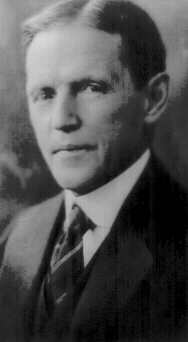William Bates (ophthalmologist)
William Horatio Bates (born December 27, 1860 in Newark , New Jersey , † July 10, 1931 in New York ) was an American ophthalmologist . He became known through an eye training ( Bates method ) developed by him and named after him , at that time the working basis of numerous so-called visual schools . The motivation for this arose in the 1920s from the increasing number of ametropolitan people in the population, especially among school children, whom Bates wanted to counteract through alternative methods.
Life
Bates graduated from private Cornell University in 1881 and received his doctorate in medicine from the prestigious Columbia University in 1885 . He published his theory in 1920 in the book Perfect Sight Without Glasses and in the magazine Better Eyesight in the years 1919 to 1930. He also researched the use of adrenal extracts, the active ingredient of which was patented and marketed as adrenaline by the Japanese Takamine Jōkichi .
Bates method
(→ main article eye training according to Bates )
Bates assumed that prolonged eye strain during puberty is more likely to lead to myopia and that eyesight fluctuates with daily mood. Around 1920 he therefore developed the first exercises for targeted “ training ” of the eyes, on the one hand to achieve relaxation and on the other hand to strengthen the eye muscles , which he assumed would have an influence on the extent of ametropia . These exercises promise significant reductions in astigmatism , nearsightedness , farsightedness and other visual disturbances if the applications are carried out consistently.
Some of these exercises should be easy to learn and immediately applicable to everyone:
- the big swing
- palming (English palm = palm of the hand)
- regular (short) sunbathing with closed eyes
- Alternating fixing and letting go of the gaze (avoiding "unhealthy" staring )
- simple exercises of eye movements , etc.
Most of the procedures, especially the first two, are intended to help prevent neck and back pain in addition to practicing relaxed vision .
The work of William Bates influenced Moshé Feldenkrais in the development of his Feldenkrais method . In Germany the approach was taken up by Maximilian Graf von Wiser . In connection with the increasing work on computer screens, similar exercises are recommended as part of company health management .
Quotes
- “Visual defects and even illness can be affected by emotional stress and pressure. It is not our eyes that let us down, but we let them down… ” (W. Bates)
Fonts
- Better eyesight without glasses. 1919. New edition 1981.
- Right vision without glasses. German first edition 1931.
- Perfect Sight Without Glasses. 1920.
literature
- Martin Gardner : Throw away your glasses! In: Fads and Fallacies in the Name of Science. Dover Publications, 1957, ISBN 0-486-20394-8 , pp. 230-241.
Web links
- Literature by and about William Bates in the catalog of the German National Library
- William Bates on vision-training.com
- Obituary July 1931 , New York Times , July 11, 1931, p. 13
- The professional association of ophthalmologists in Germany (BVA) on the Bates method
Individual evidence
- ^ William H. Bates: The Use of Extract of Suprarenal Capsule in the Eye . New York Medical Journal. Pp. 647-650. 1896.
- ↑ Jokichi Takamine: Adrenalin the active principle of the suprarenal glands and its mode of preparation . In: The American Journal of Pharmacy 73, 1901, pp. 523-535.
- ↑ http://www.pressebox.de/pressemitteilung/tuev-sued-ag/Augentraining-fuer-die-Arbeit-am-Computer/boxid/641218a
- ↑ Perfect Sight Without Glasses. Retrieved September 10, 2012 .
| personal data | |
|---|---|
| SURNAME | Bates, William |
| ALTERNATIVE NAMES | Bates, William Horatio (real name) |
| BRIEF DESCRIPTION | American ophthalmologist |
| DATE OF BIRTH | December 27, 1860 |
| PLACE OF BIRTH | Newark (New Jersey) , New Jersey , USA |
| DATE OF DEATH | July 10, 1931 |
| Place of death | New York City , USA |
